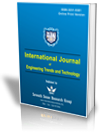Adapting RivaGAN for Robust Image Watermarking with Attention Mechanisms
Adapting RivaGAN for Robust Image Watermarking with Attention Mechanisms |
||
 |
 |
|
| © 2025 by IJETT Journal | ||
| Volume-73 Issue-4 |
||
| Year of Publication : 2025 | ||
| Author : Abdelhay Hassani Allaf, M’hamed Ait Kbir |
||
| DOI : 10.14445/22315381/IJETT-V73I4P108 | ||
How to Cite?
Abdelhay Hassani Allaf, M’hamed Ait Kbir, "Adapting RivaGAN for Robust Image Watermarking with Attention Mechanisms," International Journal of Engineering Trends and Technology, vol. 73, no. 4, pp. .81-91, 2025. Crossref, https://doi.org/10.14445/22315381/IJETT-V73I4P108
Abstract
This paper presents the adaptation of the RivaGAN framework for robust image watermarking, specifically targeting image transformations such as JPEG compression, Gaussian noise, scaling, and cropping. Attention mechanisms are employed to improve watermark embedding and extraction robustness and accuracy. The proposed method incorporates a 32-bit watermark into 512 x 512 images from the CIFAR-10 dataset, including pre-and post-processing phases, to further improve performance. The effectiveness of the technique is judged using indicators such as Peak Signal-to-Noise Ratio (PSNR), Structural Similarity Index Measure (SSIM) and Recovery Accuracy (RA). The results illustrate strong resilience to attacks, including JPEG compression and scaling, with negligible visual deterioration and excellent accuracy in watermark detection. However, the system demonstrates vulnerability to heavy Gaussian noise and cropping, where recovery accuracy significantly drops. Additionally, we evaluate the effect of pre-and post-processing on system performance under Gaussian noise conditions, highlighting their benefits in mitigating these vulnerabilities.
Keywords
Watermarking, RivaGAN, Robustness, Adversarial Networks, Attention Mechanism.
References
[1] Priyanka Singh et al., “Robust and Secure Medical Image Watermarking for Edge-Enabled e-Healthcare,” IEEE Access, vol. 11, pp. 135831-135845, 2021.
[CrossRef] [Google Scholar] [Publisher Link]
[2] Dalel Bouslimi et al., “A Joint Encryption/Watermarking System for Verifying the Reliability of Medical Images,” IEEE Transactions on Information Technology in Biomedicine, vol. 16, no. 5, pp. 891-899, 2012.
[CrossRef] [Google Scholar] [Publisher Link]
[3] Souha Mansour, Saoussen Ben Jabra, and Ezzedine Zagrouba, “A Robust Deep Learning-Based Video Watermarking Using Mosaic Generation,” VISIGRAPP, vol. 5, pp. 668-675, 2023.
[CrossRef] [Google Scholar] [Publisher Link]
[4] Aidin Ferdowsi, and Walid Saad, “Deep Learning-Based Dynamic Watermarking for Secure Signal Authentication in IoT Things,” IEEE International Conference on Communications, Kansas City, MO, USA, pp. 1-6, 2018.
[CrossRef] [Google Scholar] [Publisher Link]
[5] J.R. Hernandez, M. Amado, and F. Perez-Gonzalez, “DCT-Domain Watermarking Techniques for Still Images: Detector Performance Analysis and a New Structure,” IEEE Transactions on Image Processing, vol. 9, no. 1, pp. 55-68, 2000.
[CrossRef] [Google Scholar] [Publisher Link]
[6] H. Oktay Altun et al., “Optimal Spread Spectrum Watermark Embedding via a Multistep Feasibility Formulation,” IEEE Transactions on Image Processing, vol. 18, no. 2, pp. 371-387, 2009.
[CrossRef] [Google Scholar] [Publisher Link]
[7] Frank Hartung, and Bernd Girod, “Watermarking of Uncompressed and Compressed Video,” Signal Processing, vol. 66, no. 3, pp. 283-301, 1998.
[CrossRef] [Google Scholar] [Publisher Link]
[8] Sneha Kadu et al., “Discrete Wavelet Transform-Based Video Watermarking Technique,” International Conference on Microelectronics, Computing and Communications, Durgapur, India, pp. 1-6, 2016.
[CrossRef] [Google Scholar] [Publisher Link]
[9] Ashish M. Kothari, and Ved Vyas Dwivedi, “Transform Domain Video Watermarking: Design, Implementation and Performance Analysis,” International Conference on Communication Systems and Network Technologies, Rajkot, Gujarat, India, pp. 133-137, 2012.
[CrossRef] [Google Scholar] [Publisher Link]
[10] S. Pereira et al., “Template-Based Recovery of Fourier-Based Watermarks Using Log-Polar and Log-Log Maps,” Proceedings IEEE International Conference on Multimedia Computing and Systems, Florence, Italy, vol. 1, pp. 870-874, 1999.
[CrossRef] [Google Scholar] [Publisher Link]
[11] Md. Asikuzzaman, and Mark R. Pickering, “An Overview of Digital Video Watermarking,” IEEE Transactions on Circuits and Systems for Video Technology, vol. 28, no. 9, pp. 2131-2153, 2018.
[CrossRef] [Google Scholar] [Publisher Link]
[12] Jiren Zhu et al., “HiDDeN: Hiding Data with Deep Networks,” Proceedings of the European Conference on Computer Vision, pp. 657-672, 2018.
[Google Scholar] [Publisher Link]
[13] Xinyu Weng et al., “Convolutional Video Steganography with Temporal Residual Modeling,” arXiv Preprint, pp. 1-11, 2018.
[CrossRef] [Google Scholar] [Publisher Link]
[14] S. Biswas, S.R. Das, and E.M. Petriu, “An Adaptive Compressed MPEG-2 Video Watermarking Scheme,” IEEE Transactions on Instrumentation and Measurement, vol. 54, no. 5, pp. 1853-1861, 2005.
[CrossRef] [Google Scholar] [Publisher Link]
[15] Dajun He, Qibin Sun, and Qi Tian, “A Semi-Fragile Object-Based Video Authentication System,” IEEE International Symposium on Circuits and Systems, Bangkok, Thailand, vol. 3, pp. 111-111, 2003.
[CrossRef] [Google Scholar] [Publisher Link]
[16] Nie Jie, and Wei Zhiqiang, “A New Public Watermarking Algorithm for RGB Color Image Based on Quantization Index Modulation,” International Conference on Information and Automation, Zhuhai, Macau, pp. 837-841, 2009.
[CrossRef] [Google Scholar] [Publisher Link]
[17] Kangli Hao, Guorui Feng, and Xinpeng Zhang “Robust Image Watermarking based on Generative Adversarial Network,” China Communications, vol. 17, no. 11, pp. 131-140, 2020.
[CrossRef] [Google Scholar] [Publisher Link]
[18] Matthew Tancik, Ben Mildenhall, and Ren Ng, “Stegastamp: Invisible Hyperlinks in Physical Photographs,” Proceedings of the IEEE/CVF Conference on Computer Vision and Pattern Recognition, pp. 2117-2126, 2020.
[Google Scholar] [Publisher Link]
[19] Iain E. Richardson, The H.264 Advanced Video Compression Standard, Wiley Publishing, 2nd ed., pp. 1-352, 2010.
[Google Scholar] [Publisher Link]
[20] Guangyong Gao, Tianyou Xu, and Feng Hua, “Robust Image Watermarking Based on Generative Adversarial Networks for Copyright Protection,” Research Square, pp. 1-27, 2024.
[CrossRef] [Google Scholar] [Publisher Link]
[21] Debolina Mahapatra et al., “Autoencoder-Convolutional Neural Network-based Embedding and Extraction Model for Image Watermarking,” Journal of Electronic Imaging, vol. 32, no. 2, pp. 1-15, 2022.
[CrossRef] [Google Scholar] [Publisher Link]
[22] Kevin Alex Zhang et al., “Robust Invisible Video Watermarking with Attention,” arXiv Preprint, pp. 1-11, 2019.
[CrossRef] [Google Scholar] [Publisher Link]
[23] Jamie Hayes, and George Danezis, “Generating Steganographic Images via Adversarial Training,” Advances in Neural Information Processing Systems, vol. 30, pp. 1-10, 2017.
[Google Scholar] [Publisher Link]
[24] Yimeng Zhao et al., “DARI-Mark: Deep Learning and Attention Network for Robust Image Watermarking,” Mathematics, vol 11, no. 1, pp. 1-16, 2022.
[CrossRef] [Google Scholar] [Publisher Link]
[25] Vedran Vukotić, Vivien Chappelier, and Teddy Furon, “Are Deep Neural Networks Good for Blind Image Watermarking?,” IEEE International Workshop on Information Forensics and Security, Hong Kong, China, 2018.
[CrossRef] [Google Scholar] [Publisher Link]
[26] Janvi Thakkar, Giulio Zizzo, and Sergio Maffeis “Elevating Defenses: Bridging Adversarial Training and Watermarking for Model Resilience,” arXiv Preprint, 2022.
[CrossRef] [Google Scholar] [Publisher Link]
[27] Jianbo Chen et al., “Universal Watermark Vaccine: Universal Adversarial Perturbations for Watermark Protection,” Proceedings of the IEEE/CVF Conference on Computer Vision and Pattern Recognition Workshops, pp. 2322-2329, 2023.
[Google Scholar] [Publisher Link]
[28] Aidin Ferdows, and Walid Saad, “Deep Learning-Based Dynamic Watermarking for Secure Signal Authentication in the Internet of Things,” IEEE International Conference on Communications, Kansas City, MO, USA, 2018.
[CrossRef] [Google Scholar] [Publisher Link]
[29] Santi P. Maity, and Seba Maity, “Multistage Spread Spectrum Watermark Detection Technique Using Fuzzy Logic,” IEEE Signal Processing Letters, vol. 16, no. 4, pp. 245-248, 2009.
[CrossRef] [Google Scholar] [Publisher Link]
[30] Mathias Schlauweg et al., “Self-Synchronizing Robust Texel Watermarking in Gaussian Scale-Space,” Proceedings of the 10th ACM Workshop on Multimedia and Security, Oxford United Kingdom, pp. 53-62, 2008.
[CrossRef] [Google Scholar] [Publisher Link]

